Impact of row spacing on chickpea fababean and mungbean
Impact of row spacing on chickpea fababean and mungbean
Author: Rebecca Raymond (Department of Agriculture, Fisheries and Forestry, Goondiwindi), Kerry McKenzie (Department of Agriculture, Fisheries and Forestry, Toowoomba), RCN Rachaputi (QAAFI, Kingaroy) | Date: 31 Jul 2015
Take home message
- Changes in agronomy can affect yield of chickpea and fababean.
- In general increasing row spacing may decrease yield of chickpea and fababean varieties, even in a dry season.
- Optimising time of sowing and row spacing can improve yields in fababean.
- Plant population has less impact on yield – continue with current recommendations.
- Pulse crops should not only be considered as break crops but also viable, profitable cropping options.
Background and aims
Despite the potential environmental and economic benefits, the adoption of winter and summer pulse crops in the Queensland Grains Region is around 8% and 4% of total cropping area respectively, much less than what is required to keep grain cropping systems profitable in the long term. To increase the share of pulses in the total cropping area, strategies are required to enable growers to more consistently realise the potential productivity and profitability of pulse cultivars in their farming systems.
Winter pulses (chickpea and fababean) currently comprise approximately 8% of total cropped area in the Queensland Grains Region although the adoption varies from 5 to 12% depending on the growing region. Chickpea (Cicer arietinum) is the most adapted winter pulse crop in the Queensland with the area expanding to historically high levels in 2010. Seasonal yields of chickpea ranged from 0.5t/ha to 2t/ha depending on the timing and severity of biotic and abiotic stresses during the growing season. Although yields as high as 4.0t/ha have been achieved in varietal evaluation trials in favourable environments through optimal combination of varieties and management, the average yield during the 2008 – 2011 was approximately 1.2t/ha in the focus regions included in this project (ABS statistics, 2014), suggesting a significant gap between seasonal potential and harvested yields.
Fababean (Vicia faba) is gaining popularity in the northern grains region thanks to higher prices in recent seasons and improved varieties. Although southern regions dominate the production for Australia; Northern NSW and Southern Qld are looking more favourably upon fababean as part of their rotation as a break crop for disease and for its nitrogen fixing ability. Yield of fababeans ranges from 2-4t/ha however the pulse agronomy trials have shown a potential of up to 6t/ha.
Although the area sown to winter pulses in Queensland has increased over the last three years, there have been many challenges for growers with erratic seasonal conditions and a range of disease pressures on yield and quality. Growers’ attitude to pulse crops is also influenced by forecast prices relative to other cropping options including cotton and experiences from the previous season. The area of winter pulses in the region needs to be stabilised and the reliability of achieving seasonal yield potential improved.
One of the main aims of the project is to not only to get an increase in yields for winter and summer pulses, but to also improve the reliability of yields. When the risk in getting reliable yields in varied environments and seasons is reduced then pulses will not just be considered as a break crop in a cereal rotation or as an opportunistic cash crop but as a crop that can be considered a reliable and profitable part of the farming enterprise.
As an example, with mungbean yields averaging around 1t/ha in southern Queensland and a long term price of $750/t, an increase in yield of 10% could mean an extra return of $75/ha. Across a growing area of approx. 40,000ha this could mean an additional $3 million of returns to growers.
The Pulse Agronomy project has consulted widely within the pulse industry to determine the priorities to be investigated throughout the term of the project and to assist in developing trials and subsequently answers to new questions that arise.
This paper presents highlights of chickpea and fababean agronomy trials aimed at investigating row spacing and plant population effects on the yield performance of commercially relevant varieties including a pre-release line grown dryland during the 2014 winter season.
FABA BEAN
1.1 Garah
The trial design consisted of 3 varieties Cairo, PBA Warda and a pre-release line X220-D grown at 4 row spacings (0.25m, 0.5m, 0.75m and 1.00m) with a targeted density of 25 plants/m2. The trial was planted on grey vertosol which had been on a long fallow prior to planting. The crop received 96mm of in crop rain.
Results
Overall, above average yields were obtained at the Garah site and significant effects of the agronomic treatments. The highest yielding treatment was 60% greater than the lowest yielding treatment. There was deemed to be no significant difference overall between the cultivars PBA Warda and Cairo however the breeding line X220-D performed significantly better than the other two varieties (Table 1).
Table 1. Effect of cultivar on yield, Garah (LSD = 0.482)
|
Cultivar |
Grain yield (t/ha) |
|
PBA Warda |
4.41b |
|---|---|
|
Cairo |
4.09b |
|
X220-D |
4.94a |
The narrow row spacing of 0.25m has significantly out yielded other spacings at 5.51t/ha (Table 2). X220-D was significantly higher yielding than the other two cultivars at 0.25m and at 0.5m while there was no significant difference between the cultivars at 0.75m or 1.0m.
Table 2. Effect of row spacing on yield, Garah (LSD = 0.513)
|
Row Spacing |
0.25 |
0.5 |
1.0 |
|
Mean Yield |
5.51 |
4.95 |
3.25 |
|---|
Similar to the Warra site, the same trend can be found when comparing the effect of row spacing and cultivar on yield, narrower rows are gaining the highest yields (Fig 1). The pre-release variety, X220-D yielded 20% greater in the 0.25m and 0.5m treatments than both PBA Warda and Cairo.
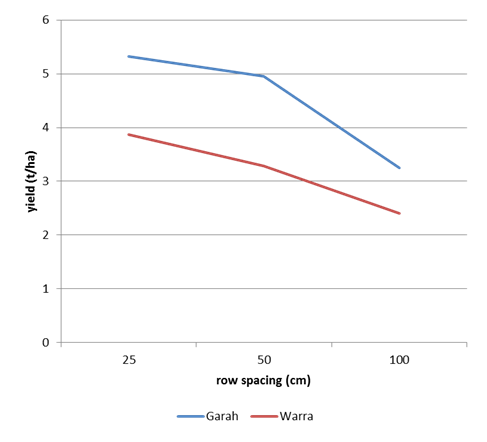
Figure 1. Effect of row spacing and cultivar on yield of fababean, Garah, winter 2014
1.2 Warra
The trial design consisted of 2 varieties PBA Warda and X220D (a pre-release line) grown in 4 row spacing (0.25m, 0.5m, 0.75m and 1.00m) at a density of 30 plants/m2. The soil type is a grey cracking clay vertosol and the trial was planted on an available water content of 140mm in 0- 120cm profile. The crop received 113mm rainfall during the season.
Results
Overall, there was no significant difference between the two cultivars (Table 3). However, significant effects of the agronomic treatments were observed with both varieties responding positively to decreasing row spacing.
Table 3. Effect of cultivar on yield, Warra, winter 2014 (LSD = 0.4915)
|
Cultivar |
Grain yield (t/ha) |
|
PBA Warda |
3.081 |
|---|---|
|
X220-D |
3.252 |
When comparing the row spacing there is a trend indicating that narrower rows are producing higher yields. There is significant difference in yield between the 0.25m and 0.5m spacing as well as between 0.75m and 1.0m (Fig 2) However, the yield response of the pre-release line X220-D to decreasing row spacing was consistent whereas the yield increment between 0.50m and 0.25m was marginal for PBA Warda.
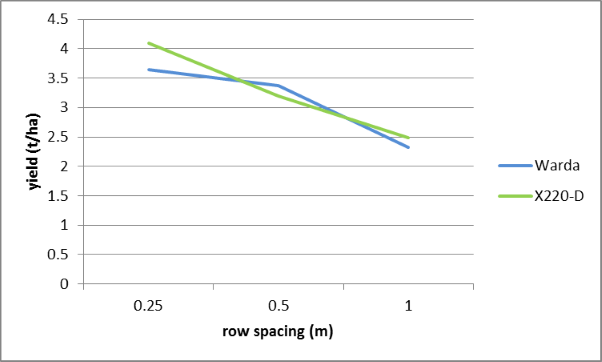
Figure 2. Effect of row spacing on yield of two faba bean varieties, Warra, winter 2014 (LSD 0.0527)
2. Effect of time of sowing on yield of faba bean
This preliminary trial was planted and managed by Glenn Milne near Dalby. The variety PBA Warda was planted into standing corn stubble on a well-structured, uniform deep to very deep, fine, self-mulching, cracking clay, with a targeted plant population of 25plants/m2 on 32cm row spacing and there were three times of sowing:
- 23 April 2014
- 19 May 2014
- 9 June 2014
There was a linear reduction in yields as the planting time delayed beyond 23 April (Fig 3). However, there was no significant difference in yield between the first and second dates nor the second and third dates but there is between the first and third dates. The first planting date (23 April) had the highest yield at 1.82t/ha, followed by the second date at 1.43t/ha and then the latest at only 0.99t/ha. This trend indicates that there is a need to investigate earlier dates of sowing with more varieties for the Southern Downs region for achieving higher yields.

3. CHICKPEA
Effects of Row spacing
3.1 Dalby
The row spacing trial design was based on genotype (3 varieties PBA HatTrick, PBA Boundary and CICA0912 an advanced breeding line), four row spacing treatments (0.25m, 0.50m, 0.75m and 1.00m). A separate plant population trial with the same varieties and 4 plant densities (10, 20, 30 and 40 plants/m2) was also conducted planted on 50cm row spacing.
The trial was planted on a well-structured, uniform deep to very deep, fine, self-mulching, cracking clay at a starting mositures of 143mm in 120cm profile. The crop received 113mm of rain during the growth phase.
Results
At the Dalby site, no significant difference was found between the varieties however CICA0912 was found to achieve the highest yield in both the 25 and 50cm row spacing, with a 30% yield increase over PBA HatTrick and a 20 % increase over PBA Boundary (Fig 4). At the 25cm row spacing, there was no significant difference between CICA0912 and PBA Boundary but there was between CICA0912 and PBA HatTrick and also not between PBA Boundary and PBA HatTrick. There were no sig. differences between varieties found at 50cm or 100cm.
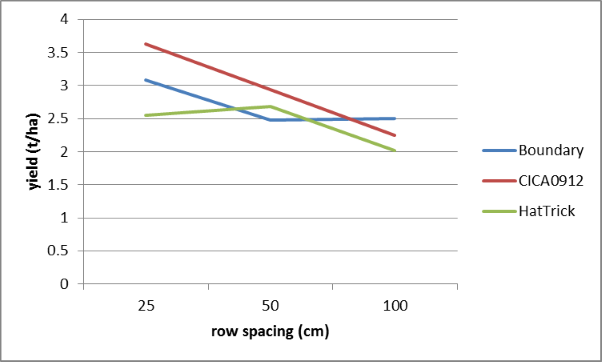
Figure 4. The effect of row spacing and cultivar on yield at Dalby, winter 2014
3.2 Billa Billa
The trial site was 40km NE of Goondiwindi on a well-structured, uniform deep to very deep, fine, self-mulching, cracking clay, grey vertosol and was planted into standing wheat stubble. The starting soil water content was 132mm in 120cm profile and the crop received 82mm of in-crop rain.
The row spacing treatments were the same as those used at Dalby.
Results
There was no significant difference between cultivars at Billa Billa nor between 25cm and 50cm rows (except for PBA Boundary), however there is difference when it comes to the 1.0m rows (Fig 5). From this trend it can be assumed that 1.0m row spacing is not optimal at this site.
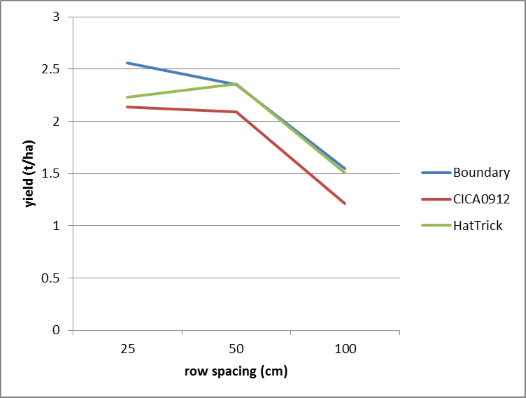
Figure 5. The effect of row spacing and cultivar on yield at Billa Billa, winter 2014 (LSD = 0.323)
Water use efficiency
Water use efficiency is a valuable measure of the potential suitability of a crop especially in the northern grains region farming systems where rainfall can be limited and temperatures high. Values for chickpeas are usually in the range of 7 to 8 kg/ha/mm water used, at Billa Billa, above average water use efficiencies were achieved.
Narrow row-spacing produced the highest WUE and PBA Boundary produced a higher WUE but statistically it was the same as was achieved by PBA HatTrick (Fig 6). Effects of row spacing was significant with 25cm resulting in higher WUE (13.l kg/mm) compared to 8.4 kg/mm in 100cm rows. However, cultivar differences for WUE was not significant. A statistically higher result in all three cultivars in the 25cm spacing over 100cm.

Figure 6. The effect of row spacing and cultivar on water use efficiency at Billa Billa, winter 2014
3.3 Garah
The trial design was the same as at the Dalby site, the chickpeas were planted into standing wheat stubble into a grey vertosol soil, with low planting moisture but opportunistic rain post planting, however a total of only 58mm in crop rain.
Results
Overall, low to average yields were obtained at the Garah site but significant affects from the agronomic treatments were achieved (Fig 7). The lower yields were due to a very low starting moisture and low rainfall throughout the season.
The highest yielding treatments being all varieties on 25cm, were 66% greater than the lowest yielding treatment (varieties at 100cm). There was deemed to be no significant difference overall between the cultivars. With the row spacing trial the trend is indicating that narrower row spacings are achieving higher yields in all three cultivars.

Figure 7. The effect of row spacing and cultivar on yield at Garah, winter 2014 (LSD = 0.288)
3.4 Warra
The trial design was the same as Dalby and Garah and the soil type was a grey cracking clay vertosol.
Results
On average, higher yields were obtained at the Warra site than at Billa Billa and Garah, and again significant affects from the agronomic treatments were achieved (Fig 8).
The highest yielding treatments being all varieties on 25cm, were greater than the lowest yielding treatment (varieties at 100cm). There was significance between each row spacing of each variety however there was deemed to be no significant difference overall between the cultivars. With the row spacing trial the trend is indicating that narrower row spacings are achieving higher yields in all three cultivars.
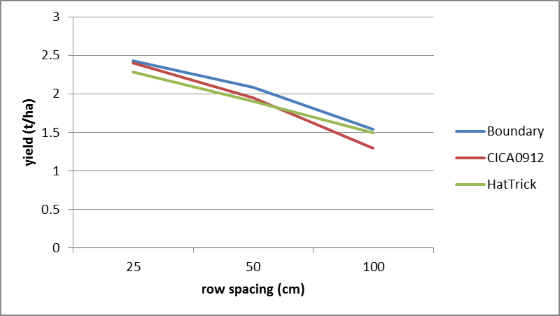
Figure 8. The effect of row spacing and cultivar on yield at Warra, winter 2014 (LSD = 0.3379)
Water use efficiency
Slightly lower WUE’s were achieved at the Warra site (grand mean 8.3) which only achieved average WUE compared with the Billa Billa site (grand mean of 10.7) which is considered above average.
Row spacing had significant effect on WUE with narrow row-spacing producing the highest WUE and CICA0912 produced higher WUE but statistically there was no difference in the WUE across cultivars (Fig 9). There was however a statistically higher result in all three cultivars in the 25cm spacing over 100cm.
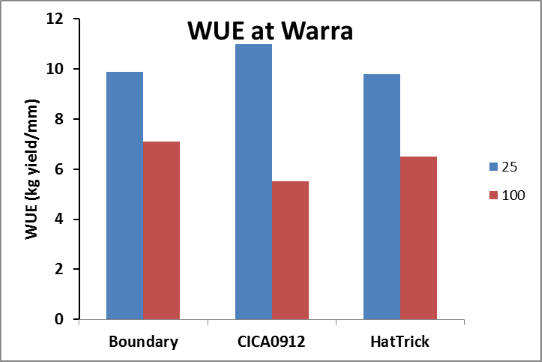
Figure 9. The effect of row spacing and cultivar on water use efficiency at Warra, winter 2014
(LSD= 1.77)
4.0 Mungbeans
The first summer pulse trials were established in the 2013/14 seasons and replicated again in 2014/15. The initial trials were based on a population trials with 3 varieties (Jade-AU, Crystal, and a pre release lines from the breeding program), planted at 10, 20, 30 and 40 plant/m2, on 50cm rows with 3 reps of each. In the first season 2 sites were planted at Warra and Dalby on the Darling Downs. In the 2014/15 season 4 sites were planted, again at Warra and Dalby, with additional sites at Billa Billa and Miles.
Row spacing trials were planted with a target population of 25plants/m2. The row spacing treatments were 25, 50, 75 and 100cm in 2013/14 and 25, 50 and 100cm in 2014/15.
The comparison of the weather between the 2 years of trials is quite stark with 2013/14 being very hot and dry, while the 2014/15 season was relatively mild for a summer plant mungbean crop. Figure 10 depicts the weather for Warra over the 2 seasons with above average high temperatures and limited rainfall (55mm in 11 falls) in 13/14, while milder high temperatures and much more in crop rain lead to a doubling of yields at this site.
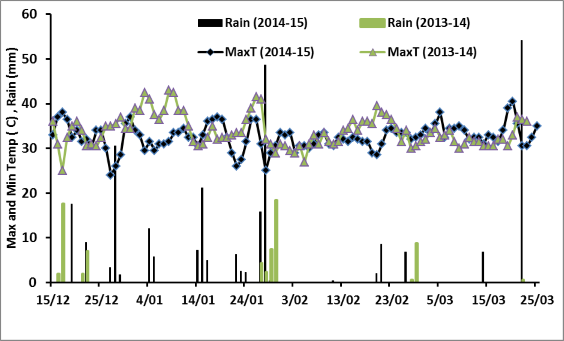
Figure 10. Comparison of 13/14 and 14/15 summers at Warra
In the 2 sites for 13/14 Jade-AU was the highest yielding variety across all row spacing treatments, followed by the other commercial large seeded variety Crystal. The small seeded pre release variety MO9246 (since released as Celera II) was much quicker to flowering and maturity and prior to harvest a portion had shelled out of the pods, losses were estimated to be as high as 30% however the stated results are as harvested and not adjusted for loss.
The highest yields at Warra were in the 25cm row spacing at 1.219t/ha, although this was not significantly better than the other row spacing treatment, with the lowest of 0.972t/ha for the 1m treatment.
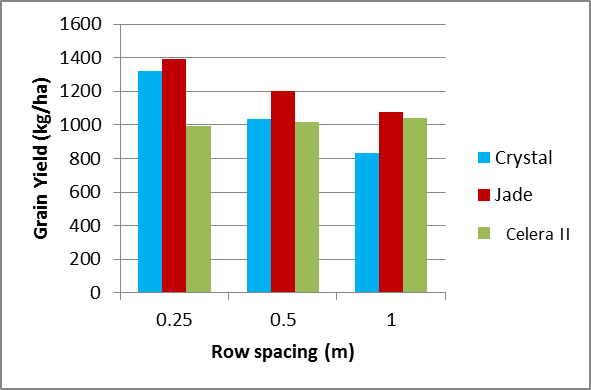
Figure 11. Grain yield of mungbeans at Warra by variety and row spacing treatment (LSD 370kg)
The 2014/15 results have not been fully analysed at the time of writing however some of the results from the Warra site have been included as a comparison to the much drier season before. In the much better weather conditions of 2014/15 yields were doubled that of the previous season.
The 2014/15 results have confirmed that Jade-AU has performed better than Crystal and 2 pre release lines (discussion limited to the commercial available varieties).

Figure 12. Warra 2014/15 mungbean variety yields, all row spacings (LSD 5% 562 kg)
The yield differences between the varieties were not significant, there is significant difference between 0.25 and 0.5m and the 1m spacing. Crystal was the only variety that had no significant difference across row spacings, the other varieties all had lower grain yields at 1m.
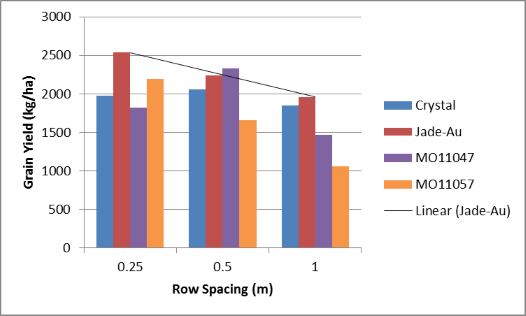
Figure 13. Warra 2014/15 mungbean grain yields variety x row spacing (LSD 5% 704kg)
Summary and conclusion
Narrower rows (0.25m and in some cases 0.5m) gave significantly higher yields for all pulse varieties at all sites. Narrow rows did not result in yield reduction even under drier conditions.
The pre-release faba bean variety, X220-D yielded 20% greater in the 0.25m and 0.5m treatments than both PBA WardaCairo and .
Earlier time of sowing dates showed to be achieving higher yields in fababean but more investigation on earlier planting dates is required.
2014 was the second winter season where these trials were conducted; the results achieved in 2014 were also consistent with the results from 2013.
Across the sites where WUE was measured, narrower rows consistently produced higher water use efficiency.
Trials are continuing in 2015 to confirm the trends seen in 2014, following harvest and analysis of 2015 winter some firm recommendations can be made around plant populations and row spacings.
Populations are not as important in determining yields and the current industries recommendations should remain as the target populations. The fact that lower populations are not reducing yields significantly may help in making replanting decisions when establishment is effected by other factors.
Acknowledgements
Many thanks the trial co-operators Glenn Milne, Wade Bidstrup, Ben Moloney and the Woods Family and support from Stephen Krosch & Katrina Conway.
The research undertaken as part of these projects is made possible by the significant contributions of growers through both trial cooperation and the support of the GRDC, the authors would like to thank them for their continued support
Contact details
Rebecca Raymond
Department of Agriculture, Fisheries and Forestry Queensland
Ph: 0428 879 900
Email: Bec.raymond@daf.qld.gov.au
